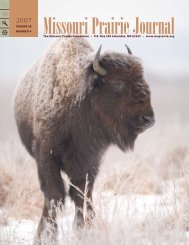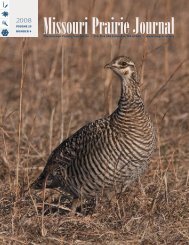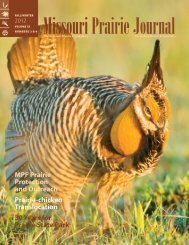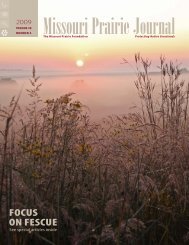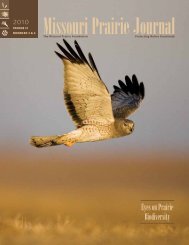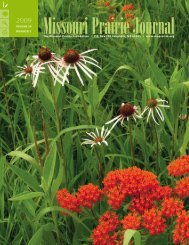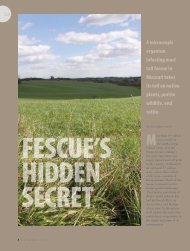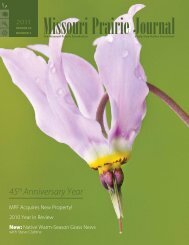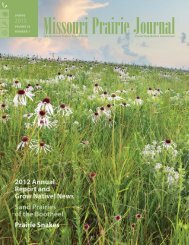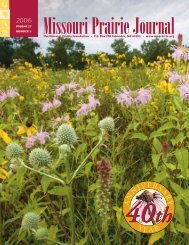St. Louis Area Urban <strong>Prairie</strong>sThe acreage nowbrimming with prairiespecies at Shaw NatureReserve (bottom photo)was formerly a fescuepasture dotted witheastern red cedar, below.Thanks to decades ofwork by MPF boardmember Bill Davit,reserve biologist Dr.James Trager, and manyother former and currentstaff and volunteers, thereserve’s grasslands aretoday rich and diverse.With plants in bloom from the first appearancein spring of lousewort, cream indigo, shootingstar and Indian paintbrush to the grand finaleof asters, goldenrods and gentians in fall, theflora of the SNR is a joy to behold and servesas a great learning resource for St. Louis areaplant enthusiasts. It is also home to a diversityof prairie animal life, including such highlightsas healthy breeding populations of prairie kingsnakes,northern yellowthroats and Henslow’ssparrows in the more open areas, and indigo buntings,orchard orioles and yellow-breasted chatsin brushier parts andwooded edges. Plansare afoot to furtherenhance the diversityof the SNR prairies,including developmentof sufficientpopulations of prairieand arrow-leavedviolets to supportan introduction of the threatened regal fritillarybutterfly, which was once native to the St. Louisregion.Finally, and rather more forb-rich but neverthelessever less distinct ecologically from thereserve’s original prairie constructions, are thespacious and showy prairie plantings associatedwith the Whitmire Wildflower Garden. Startingas a one-acre prairie garden, SNR’s horticulturestaff has gradually expanded prairie plantingsonto the gently rolling acreage south of the moreformal parts of the garden. In the garden itself,prairie plants are labeled, as are several hundredother <strong>Missouri</strong> native plant species.Dr. James Trager, biologist,Shaw Nature ReserveLocation: Shaw Nature Reserve is located at theintersection of Interstate 44 and Highway 100at Gray Summit. For more information,visit www.shawnature.org or call 636-451-3512.Bill davitScott WoodburyThe Litzsinger RoadEcology Center <strong>Prairie</strong>The Litzsinger Road Ecology Center (LREC) is a34.5-acre environmental education center managedby the <strong>Missouri</strong> Botanical Garden and islocated in St. Louis County. The LREC is notopen to the public. Primarily the facilities andgrounds are used for K-12 student field studyand ecological research. Students in St. Louis areaschools visit the site multiple times throughoutthe year to learn about restored prairie, bottomlandforest, and creek ecosystems throughscientific inquiry and by helping with ecologicalrestoration. The LREC averages several thousandstudent visits per year. The LREC also offers fiveresearch grants each year to undergraduate, graduateand faculty researchers to conduct ecologicalresearch on site. Current research projects includethe effects of invasive plant species on nativeplant species pollination, invasion patterns of the18
Japanese pavement ant, movement of rattlesnakemaster pollinators, structure and organization ofurban butterfly communities, and interactionsbetween wild senna and herbivores.Restoration efforts began on site in 1989with the restoration of 10 acres of mesic to wetmesic prairie. The original restoration effortincluded grass seeds from a nursery near KansasCity and locally collected forb seeds. <strong>Prairie</strong> restorationhas continued with another two acresof prairie restored between 1999 and <strong>2007</strong>.The seeds for this restoration were all collectedwithin 100 miles of the LREC. The big bluestemwas collected from Calvary Cemetery andis now being collected from the LREC restorationto contribute to the restoration of CalvaryCemetery’s prairie. The prairie restorations haveapproximately 216 plant species, of which 179are native to <strong>Missouri</strong>. Characteristic plants ofwet mesic prairie that are present at the LRECinclude big bluestem, prairie cord grass, switchgrass, sweet coneflower, foxglove beardtongue,rattlesnake master, bottle gentian, ragged orchid,and bunchflower.The 14 acres of bottomland forest at theLREC are in the process of restoration. Becauseof the proximity to Deer Creek, an urban stream,the forest often experiences flash flooding, sedimentdeposition, and the invasive plant speciesoutbreaks that follow. The creek also bringswater-loving wildlife to the area, however. Nearly100 species of birds, 18 species of mammals, 10species of amphibians, 23 species of reptiles, andmany species of invertebrates have been recordedat the LREC.Malinda W. Slagle, restoration ecologist,Litzsinger Road Ecology CenterThe LREC is not open to the public, but if you areinterested in conducting a K-12 field study or ecologicalresearch at the LREC, please contact MarthaSchermann at martha.schermann@mobot.org or314-442-6717.Canada wild rye grass,top, catches the lightat the Litzsinger RoadEcology Center prairie.Hundreds of studentsvisit the LREC prairieevery year, learningabout an ecosystem thatonce covered 17% ofSt. Louis County.CaptionBilL Davit Photos Heather Wells-sweeney19




